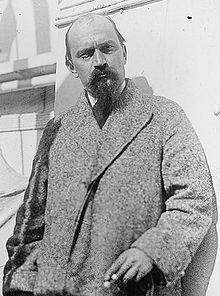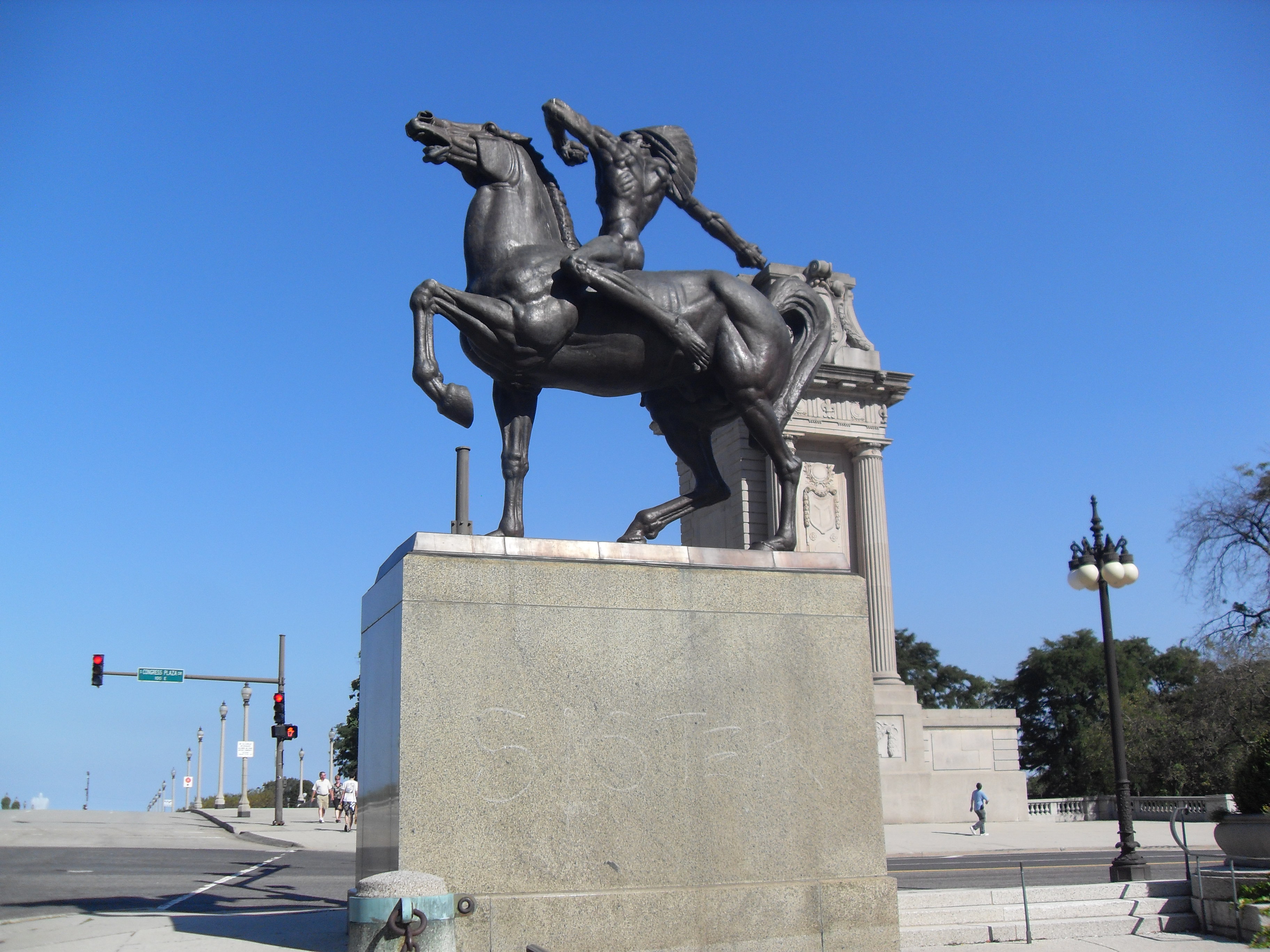If you’ve been paying attention since 1928, you might have noticed the two large equestrian statues on opposite sides of the Congress Parkway, just east of Michigan Avenue. They are The Bowman and The Spearman, sculpted and cast by Croatian artist Ivan Meštrović.

The Bowman
1928

The Spearman
1928
The stories of how they came to be and about the original idea for the commission are remarkable, as is what Ivan Meštrović was paid for them in 1928. But we’ll get to that.

Ivan Meštrović (1883-1962) was born in Vrpolje in Croatia. He arrived in America for his first visit in 1924. By then he was a famous artist in Europe and his arrival in America was highly anticipated. However, he was not arriving in good shape. Rather, he was having financial trouble and hoped a planned exhibition of his works would help get him back on his financial feet. The idea of the visit also contained elements of getting away from both family and political difficulties. (1)
His first visit was a success. His arrival was hailed in art circles and his exhibits were lucrative. He had shows in multiple locations, including the Brooklyn Museum, the Art Institute of Chicago, and the Detroit Institute of the Arts. (2) While he was initially very concerned about the cost of shipping and exhibiting slightly more than 100 sculptures from Croatia to the United States, the sales of his works here more than justified the expense.
He made a second visit to the U.S. in October, 1925. He had returned to Croatia in May of that year to be with his new son Tvrtko and to settle some difficult family matters. Tvrtko’s mother, Olga Kestercanek, was the woman
Meštrović had openly taken up with, though he remained married to Ruza Klein Meštrović until 1942, when she died (he immediately married Olga upon Ruza’s death). He was “unhappy about leaving his family and country” to travel to America again, but he needed to make the trip because at the time of his [earlier] exhibition at the Art Institute of Chicago, he had heard talk of a major commission for a monument in the city.” (3)
Meštrović’s brother Petar, who had remained in the U.S., had been corresponding regularly with Robert B. Harshe, Director of the Art Institute of Chicago. According to Maria Meštrović, a letter from Mr. Harshe to Petar, dated October 19, 1925, made it clear that this correspondence occurred during the time “the Art Institute acquired [Ivan Meštrović’s] marble sculpture My Mother for its permanent collection.” The letter “referred to the decision of museum directors to entrust an important public monument to Meštrović. . . . That was the beginning of the story of the equestrian statues [originally] named The Indians of Chicago. The contract for the work, to be paid for by the B. F. Ferguson Fund, was signed on March 4, 1926. (4) However, it took much negotiation prior to that date to determine what the “monument” would look like and what its site would be.
The Ferguson Fund was managed by the Art Institute’s directors, whose chair at that time was Potter Palmer II, who had, with his brother Honore, inherited his father’s estate, which included the famous Palmer House Hotel. Early in 1926 the fund board had not agreed on the subject of the sculpture, nor on whether they wanted a full sculpture or a bas-relief. Harshe asked that Meštrović come to Chicago to present his own views.
By the time Meštrović arrived to make his case, the board had decided it wanted two sculptures: a “ploughman sitting on an ox” to symbolize the white race and “an Indian sitting on a buffalo,” representing Native Americans. Meštrović was not interested in either of those figures because, he said, the animals could only “be treated as volume,” without hope of their having any “plastic thrust. They did not posses the rich lines crucial to a sculptor.” His plan was to provide a horse, which “represented nobility, beauty and force.” Finally, the board accepted Meštrović’s proposal “on condition that the horse was to be a Mustang, as the Indians had ridden them.” Meštrović convinced the board to accept two horses: “one for a cowboy, the other for an Indian.” (5)
Meštrović soon sent a model of “a naked Indian on a Mustang” to the board and they decided that there should be two “Indians on horseback,” to which Meštrović agreed. He was successful in his stipulations: “To model and cast in bronze two 17-foot-high equestrian monuments, weighing 15,000 pounds each, [he] asked for a period of two years and a fee of 150,000 dollars to be paid in three instalments [sic].”
The final complication in the saga occurred just as Meštrović was preparing to return to Zagreb. The board “asked him to change the position of the arms of the Indian holding a spear in his left hand. This meant that he also had to alter the right arm, to reconcile this with the direction that the bow and arrow of his companion was pointing. Meštrović later decided to do without the spear, bow and arrow, which meant making a new model and presenting it for approval.” He asked Harshe for a delay so that he could make the changes in Croatia and send a new model from there.” The board finally approved the statues, both without actual weapons. (6)
Meštrović completed the first statue by the end of 1926, and the second by May, 1927. “When the Indians left the foundry – still located next to the Academy of Fine Arts – on a cart drawn by six horses, the people of Zagreb came out of their houses to bid them farewell, as if it were a funeral.” The sculptures traveled by train to Trieste and were placed on the President Wilson to New York. They traveled by train from New York to Chicago in four huge crates. (7) (8)
Underneath it all, during the negotiations on the monuments Meštrović had his own personal agenda with respect to what he wanted to depict. A Serbian friend told me that in the Balkans, social status has much to do with where one is from. A native of a city like Belgrade or Sarajevo has higher status than someone from a neighboring village; and the villager has higher rank than a person from a farm, never mind such people as miners. That’s a gross simplification, but it’s roughly how social acceptance is determined. She said, “the rich live in the cities and the poor, the unsophisticated, live in villages and on farms.”
She translated the commentary of a Croatian scholar in a video about Ivan Meštrović: “Indians are very similar to our [Croatian] miners. They were treated as lesser. They were even hated. The original idea [for these sculptures: a farmer and an Indian] was not done. Meštrović saw in the Indians the fight for survival. Meštrović compared the struggle of the Indians as a lower class with the struggles of the Croatian people. . . . People from Dubrovnik laughed at people from Herzegovina [where Meštrović was born] when they came to the city. That [relationship/phenomenon] was always very powerful. On the one hand he had a complex about it; on the other it gave him strength that he came from that background.” (9)
So it’s no wonder that Meštrović rejected the idea of a white “ploughman” on an ox and a Native American on a “buffalo.” Meštrović’s argument of “volume” versus “plasticity” was, in reality, a convenient way both of saying “no” and of keeping his own counsel. Meštrović saw himself as a man of the people, and his art brought out the hero in ordinary people.
After World War II, Meštrović accepted the position of Professor of Sculpture at Syracuse University, where he and his family resided from 1946 through 1954. He became a U.S. citizen in 1954. By 1954, however, the studio afforded him by Syracuse became too small and the university lacked the resources to build a larger one. That same year, Father Theodore Hesburgh offered him a much larger studio and the position of Artist in Residence at Notre Dame University. He moved to South Bend in 1955 and continued his work there until his death in January, 1962. The Notre Dame campus and the collection of Notre Dame’s Snite Museum of Art include several of his works. His burial place is in Otavice, Dalmatia. His papers are archived at Syracuse University and Notre Dame.
As a final note, let’s think on the fee that this low-born man of the people extracted from the Ferguson Fund for the two statues we know today as The Bowman and The Spearman. In today’s dollars, Meštrović’s 1926 fee of $150,000 would amount to $2.1 million, a sum that would not be, shall we say, available from the Ferguson Fund in our time. No wonder he returned to Zagreb a happy man in 1926.
(1) The information on Meštrović’s life and his stay and work in the U.S. derives from Meštrović, Maria. “America”, Chapter 7 in Ivan Meštrović: The Making of a Master (London: Stacey International, 2008), pp. 145-167.
(2) McCormick, Robert B., “Ivan Meštrović ,” in Ivan Meštrović at Notre Dame: Selected Campus Sculptures. University brochure on its holdings of
Meštrović’s works (University of Notre Dame Snite Museum, of Art, 2003), p. 18. https://sniteartmuseum.nd.edu/assets/134727/mestrovic2_8.5_mb_pdf_.pdf
(3) Meštrović, Maria. Ivan Meštrović, p. 165
(4) Meštrović, Maria. Ivan Meštrović, p. 165
(5) Meštrović, Maria. Ivan Meštrović, p. 166
(6) Meštrović, Maria. Ivan Meštrović, p. 166
(7) Meštrović, Maria. Ivan Meštrović, p. 167
(8) (9) The very interesting long video about Meštrović includes a segment showing him working on the sculptures in Zagreb, as well as the horse-drawn cart taking them to the train at https://www.youtube.com/watch?v=vdtM_WZOY_s&feature=youtu.be. The footage with the cartage of the statues runs from 36:56 – 38:58. The commentary by a Croatian scholar is found at 38:58 – 39:46.
© Edmund J. McDevitt
January, 2019


Thanks Ed, great work